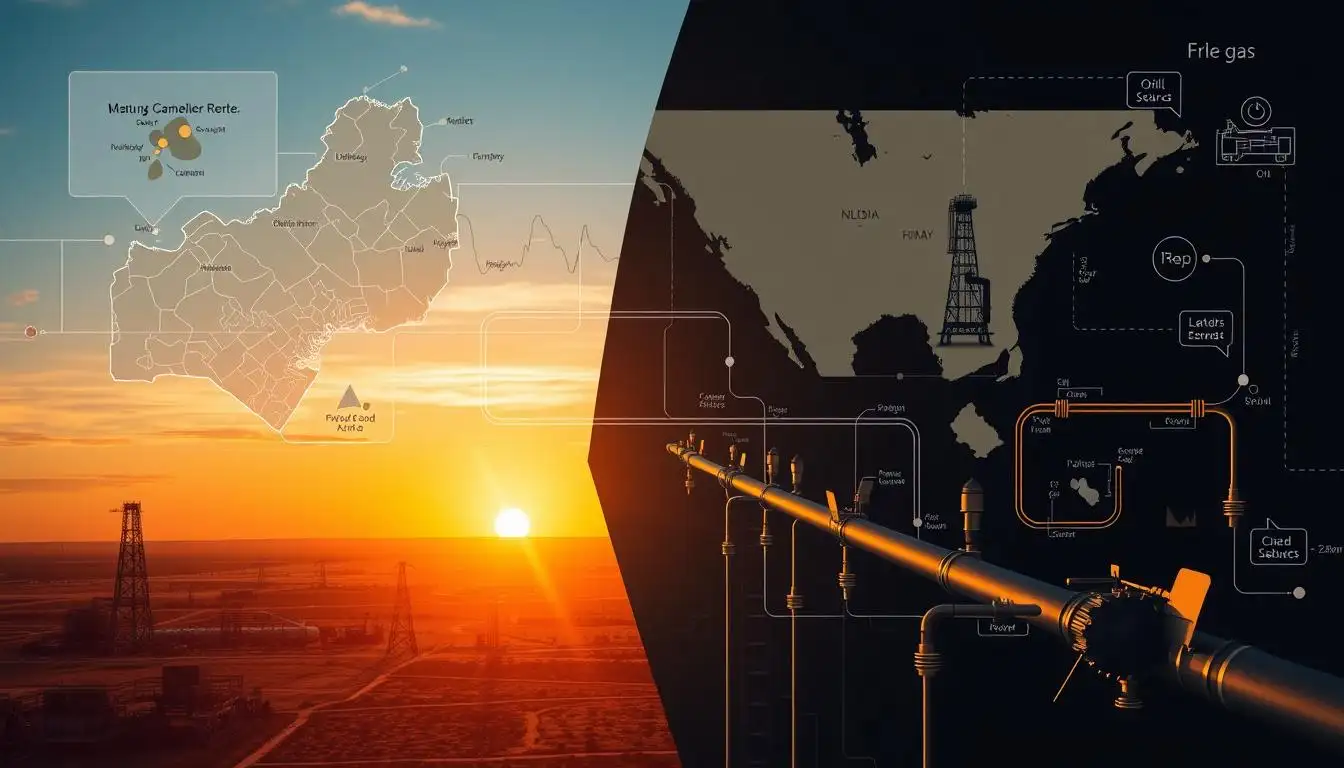Physical Address
304 North Cardinal St.
Dorchester Center, MA 02124
Physical Address
304 North Cardinal St.
Dorchester Center, MA 02124
Discover what Area Of Mutual Interest (AMI) means in oil and gas agreements, how it benefits operators, and the key legal aspects of these strategic partnerships

In the world of oil and natural gas, companies often team up. They share the risks, costs, and possible rewards of exploring and developing new areas. The Area of Mutual Interest (AMI) agreement is a key tool for this collaboration. It outlines the rights, duties, and financial commitments of each company involved.
AMI agreements are common in the oil and gas sector. They let companies work together to explore, develop, and extract resources in a specific area. These contracts detail the area’s boundaries, each company’s share, and the rules they must follow. By teaming up, companies can better handle risks and enjoy the benefits of their combined efforts.
An Area of Mutual Interest (AMI) is a common deal in the oil and gas world. It’s especially seen among joint ventures, oil exploration, and natural gas companies. These deals set a geographic area where all parties agree to share news about new oil and gas finds.
The main points of an AMI agreement are:
AMI deals have a few key parts:
The contract must clearly describe the area covered by the AMI. This is to meet legal needs. It might use landmarks, coordinates, or other clear boundaries to show the area.
AMI deals help everyone work together. They reduce competition to buy more land around the contract area. This makes it easier for oil exploration and natural gas companies to work together.
When you sign an Area of Mutual Interest (AMI) agreement, following the Statute of Frauds is key. This law requires a clear description of the land in the contract. It also says that ending an AMI agreement must be in writing and signed by both parties.
AMI agreements must follow the Statute of Frauds. This means the land description in the contract must be clear enough to identify it without needing extra evidence. Not following this rule could make the agreement hard to enforce.
An AMI agreement needs certain key parts. These include rules for giving notice, time to make choices, and how costs will be shared. These parts help ensure everyone knows what’s happening and who’s responsible for what.
The length of an AMI agreement is set in the contract. But, it’s important to remember that rules about enforcing the agreement might not start until a lot of time has passed. This is especially true if the necessary notices weren’t given.
| Legal Requirement | Description |
|---|---|
| Statute of Frauds | Requires the land involved in the AMI agreement to be described in the contract with sufficient detail to identify it without the need for parol evidence. |
| Termination | Termination of an AMI agreement must be in writing and signed by the parties to be charged with enforcement. |
| Essential Provisions | AMI agreements should include notice requirements, election periods, and cost-sharing mechanisms. |
| Duration | The duration of an AMI agreement is typically defined in the contract, but limitations on enforcement actions may not begin to run for a very long time, especially if required notices are not given. |
Knowing the legal rules and what’s in an AMI agreement helps protect everyone’s interests. It makes sure the agreement is followed correctly and understood by all.
An Area of Mutual Interest (AMI) agreement helps companies work together. They share the benefits of exploring and developing a contract area fairly. This way, no one uses data for their own gain, promoting cooperative exploration and data utilization.
AMI agreements also let companies get a share in each other’s projects. This risk sharing helps spread out the costs and risks of finding and developing resources.
Moreover, AMIs reduce competition for more land around the contract area. This leads to a competitive advantage through cooperative behavior. Companies can use their combined skills and resources more efficiently.
“In the technology sector, software companies often form partnerships with hardware manufacturers to ensure compatibility and optimize user experience. Pharmaceutical companies collaborate with research institutions in the healthcare industry to accelerate the development of new drugs.”
AMI agreements are beneficial in many fields, like energy, tech, healthcare, and renewable energy. They help companies share risks, explore together, use data wisely, and gain a competitive edge. This way, they can get more benefits while facing fewer risks in resource development.

Area of Mutual Interest (AMI) agreements often include cost sharing and profit distribution among parties. These agreements match each party’s share with their ownership percentage. A designated operator may handle operational responsibilities, while others have non-operator status.
AMIs may create fiduciary duties for those who administer them, especially if they get special benefits. Joint operating agreements often work with AMIs to manage daily operations and decision-making.
The cost sharing in AMI agreements matches the parties’ ownership interests. This ensures each party shares the risks and expenses fairly.
The profit distribution methods in AMI agreements also follow ownership percentages. This way, rewards are shared fairly among participants.
AMI agreements often name a specific party as the operator. This party handles the daily operational management. Non-operating parties still have a stake in the project, even if they don’t make decisions.
| Key Aspects of AMI Agreements | Description |
|---|---|
| Cost Sharing | Aligned with ownership percentages to ensure proportionate risk-bearing |
| Profit Distribution | Based on ownership percentages for fair and equitable allocation of rewards |
| Operational Responsibilities | Designated operator oversees day-to-day management, with non-operating parties maintaining a stake |

“The decision to include AMI or preferential rights provisions in a joint operating agreement should not be taken lightly and requires careful drafting.”
Area of Mutual Interest (AMI) agreements are complex legal tools. They need careful drafting and thorough checks. Investors and operators in the oil and gas field must understand their long-term effects.
These agreements affect future property deals. Knowing how AMI provisions work is key to handling joint projects.
AMI agreements are crucial in the oil and gas world. They help set up partnerships and manage shared mineral rights. Companies must be careful when making these agreements.
They need to follow the law and clearly state terms like where to work, how to split costs, and who does what. This ensures everyone knows their role.
Managing AMI agreements well helps avoid risks and makes joint ventures work better. By focusing on detailed contracts and doing thorough checks, companies can succeed in the oil and gas field.
An Area of Mutual Interest (AMI) is a specific area where two or more oil or natural gas companies share a stake. AMI contracts outline the area, each party’s rights, the agreement’s term, and how to follow the contract.
An AMI agreement has several key parts. These include the area, each party’s rights, the agreement’s length, and how to follow the contract. These agreements are made specifically for the involved parties.
AMI agreements encourage cooperation by limiting competition for more leases around the area. They let parties share interests in each other’s deals, splitting risks and rewards.
AMI agreements must follow the Statute of Frauds. This means the land must be clearly described in the contract. Also, ending an AMI agreement must be in writing and signed by all involved.
Important parts of an AMI agreement include notice rules, election times, and how costs are shared. The agreement’s length is set, but enforcement actions can be delayed if notices are not given.
The main goal of an AMI is to ensure companies work together in the contract area. This prevents any party from using shared data for personal gain.
AMI agreements often have rules for sharing costs and profits. These usually match each party’s ownership share. One party might be in charge of operations, while others are non-operators.
AMI agreements are complex and need careful creation and review. It’s important for all involved to understand the long-term effects. Knowing the AMI details is key to successful joint oil and gas projects.